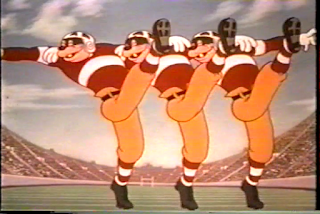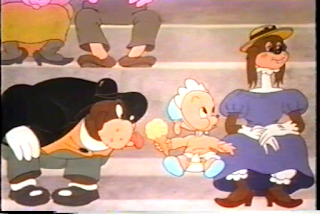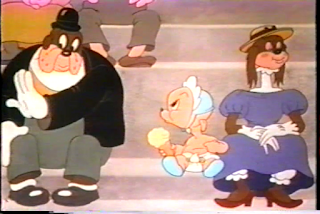DVD-Blu-Ray Availability: none
You may view the uncensored version of this cartoon HERE.
More spot gags? As if we have a choice. This one has a welcome looseness, and is less reliant on deliberately stinky puns and other verbal-humor quips.
Thanks to this not being reissued, and thus shorn of its elaborate original titles, we can enjoy an unusual approach, via animated silhouettes. There's a funny gag, and everything:
These credits have more laughs than the entirety of, say, A Day at the Zoo, so this is off to a promising start--despite its being a sports cartoon. Not being a sports person, and finding sports, as-is, already funny, I am prone to groan when an athletic theme dominates an animated film.
We are spared the worst, as Avery and his crew seem to see an absurdity inherent in the game of football--as much an agent of fanatical devotion then as now. Robert C. Bruce is back on board as our know-it-all narrator, and his easygoing voice brings a lot to these cartoons.
We are spared the worst, as Avery and his crew seem to see an absurdity inherent in the game of football--as much an agent of fanatical devotion then as now. Robert C. Bruce is back on board as our know-it-all narrator, and his easygoing voice brings a lot to these cartoons.
"Here we are at the famous Chili Bowl Football Classic, the biggest game of the year..."
Delay action on the dog's jowls, as he feigns nonchalance, show a minute Disney influence.
Chaotic crowd scenes often look like a mess when still-framed. These are nicely composed and funny images, with small details destined to be lost on their original audience.
Returning from Dangerous Dan McFoo is the proto-Droopy schlep, as "Gregory," the bench-warmer given the chance of a lifetime by a jowl-flapping bulldog coach (voiced by Mel Blanc).
"Great game, Gregory," Coach Bulldog says. This, to me, is the absurdity of football defined.
soon-to-be-famous Bugs Bunny voice...
for this great image.
Bruce says the weather is almost perfect for the game...
"There's just one small cloud in the sky..."
Bruce notes the "colorful" crowd, seated by hue. Segregation was never so funny!
"The huge bowl is filled to overflowing..."
Nothing at all grotesque about that final image. Nope.
Bruce notes the wide age range of the spectators, then pauses to admire a charming tot.
"(chuckle) This fella seems more interested in his ice cream cone!"
His interest is shared by (possibly itinerant) bulldog seated stage left.
Hey--I think this might be our wraparound gag. All spot gag cartoons worth their salt have to have one of these. This is among the better wrappers in the troubled genre.Delay action on the dog's jowls, as he feigns nonchalance, show a minute Disney influence.
That ice cream theft is going to lead to tragedy, I assure you.
We turn our attention back to the football field, where we see "halfback Stickovitz
kicking a few field goals," Perry Como-style.
This next bit plays out well, and, though borrowed from earlier cartoons, it must have floored 1939 audiences, who had forgotten that they might expect such tomfoolery--even in an animated cartoon:
This gag, like many in Avery's early cartoons, is an elaboration on the low-brow knockabout comedy of late silent and early talkie animation. In this case, this is a variant on a bit in the Van Beuren cartoon The Big Cheese (1931). Avery made no claim that these gag routines were in any way new. How he treats them, in terms of timing and character, is the crucial difference.
Few 1931 cartoons, tho' wonderful as a body of work, have sharp timing. (That said, the timing of this (and other late '30s Avery cartoons) looks stilted in comparison with his best M-G-M animation.)
Theatrical cartoons are about progress and regression. The best of them take much-used material and bring it to new life through the lens of progress. The crude cavorting of John Foster's 1931 VB short was on the lower end of the animation spectrum. The Krazy Kat and Oswald the Rabbit cartoons of that same year have much more on the ball; the Fleischer shorts are an emesis of hallucinatory images, sometimes dully-timed but always astonishing. Hugh Harman and Rudy Ising's shorts for Warner Brothers suffer from metronomic timing, but have plenty of good-natured pep and hot music.
Theatrical cartoons are about progress and regression. The best of them take much-used material and bring it to new life through the lens of progress. The crude cavorting of John Foster's 1931 VB short was on the lower end of the animation spectrum. The Krazy Kat and Oswald the Rabbit cartoons of that same year have much more on the ball; the Fleischer shorts are an emesis of hallucinatory images, sometimes dully-timed but always astonishing. Hugh Harman and Rudy Ising's shorts for Warner Brothers suffer from metronomic timing, but have plenty of good-natured pep and hot music.
That Avery, Frank Tashlin and other major directors of the late '30s and early '40s, took so much from these earlier cartoons (which must have seemed quaint and creaky by the start of the new decade), and made so much of it fresh again, is one of the great magic-acts of American film-making. Both men worked in animation in 1931, and both apparently had good memories.
A cartoon of 1939 could not be less like one from 1931. It's fascinating to see how Avery, and a handful of other directors, renewed the spirit of these early talkie cartoons and made it part of a growing modern vision of what animation could be.
Avery's brilliant addition to this stock gag occurs in the moment when the football toughs look at each other, and tacitly agree to go into their dance. The dance doesn't just happen--it is preceded by a moment of "should we do this?" All the Schlesinger directors would bring this extra layering to their cartoons in the 1940s.
Back to today's feature: The ref calls the captains over--his goal to flip a coin and decide which team goes first. You know what's going to happen when that coin hits the ground:
The mad scramble (again reminiscent of fight scenes from the Van Beuren cartoons)
is full of funny, well-composed drawings.
is full of funny, well-composed drawings.
Pity that only the animators really got to see this stuff at the time...
We're almost two minutes into this picture, so let's get down to an attempt at a football game.
A very 1939-looking ref blows a moist-looking whistle...
The kickoff hews to a crucial Avery rule: start off serious...
...then get stoopid.
It takes the kicker a LONG time to figure out what's just happened.
He has to look a second time.
He still hasn't tallied up the situation.
Bruce exhorts us to "listen to that crowd roar..."
Standard lion SFX (of course) are heard.
Ref decides to re-do the kick-off.
Again, the golden rule is followed...
Golf is even goofier than football, and the kicker's fussy moves with his "club" are beautifully timed. We're still in that ugly late '30s animation look, which has come and gone in the Avery unit's films of this year. Things are on the verge of turning into the 1940s, and the gloriously nice character designs of 1943-1949 are just a gleam in some artist's eye at this moment. The growing quality of the movement is striking. Once character design catches up with these technical improvements, we will have the classic '40s Hollywood studio cartoon in its essence.
Bruce: "It looks like [unintelligible name] is going to get it in the end zone."
"He did."
More pigskin action, with an elaborate set-up for one of the
hoariest cartoon gags of them all...
Bruce is a perfectly breathless sports announcer, and a fine counterpoint to the exaggerated, intense animation of this bit of business.hoariest cartoon gags of them all...
Chaotic crowd scenes often look like a mess when still-framed. These are nicely composed and funny images, with small details destined to be lost on their original audience.
"Palookavitch is hurt in the play! Time is out."
Admit it--you know which of the two objects the medics are gonna go for.
This bit of business had been used recently in a Fleischer Studio Popeye short, and will continue to appear in other animated shorts. Avery loves to bundle cliches, so without a pause, we witness another time-worn convention of sports movies.Returning from Dangerous Dan McFoo is the proto-Droopy schlep, as "Gregory," the bench-warmer given the chance of a lifetime by a jowl-flapping bulldog coach (voiced by Mel Blanc).
"Now get in there..."
"...and fight!"
Gregory takes more time to get into the game that he lasts in it.
We hear four seconds of sound effects and see the coach's horrified reactions.
With dynamite timing, a fully-bandaged Gregory is thrown from the fracas and hits the wall."Great game, Gregory," Coach Bulldog says. This, to me, is the absurdity of football defined.
Fade to black; fade in on a return to our wraparound narrative.
Back to more thrills of the gridiron.
A periscope seems perfect for a football huddle.
QB literally "barks" his play--shades of "Bugs" Hardaway--and Avery cuts to a diagrammatic view of the team hopping like trained fleas to his commands.
QB gets the ball...
and "fades back for a long pass." Again--literally.
Football bounces off the belly of a team member--"a fumble"--
"Blobovitz recovers the pigskin..."
which, in a grotesque bit, squeals and wriggles like an actual pig.
It attempts to limp away on its own.
Filler crowd scene.
More wriggling, complex masses of movement. Bruce wonders,
with convincing concern: "Is it a touchdown... is it?"
Player squeezes out from this writhing lump of athletic action to intone, in Mel Blanc'ssoon-to-be-famous Bugs Bunny voice...
"Ehhhh... could be!"
The animation of the referee is especially nice-looking, so it's good that he has a pantomime bit. Raising the pistol to sound halftime, he gets hypnotized by his ticking, pulsing watch, and...
The development of "the Avery take" is a fascinating part of the fabric of his WB cartoons.
The spectators "change sides" for the second half of the game:
And we check in on our narrative event of note:
The glory of the halftime show merits a trumpet fanfare for one:
Always end on an erection-loss gag! Here comes the pep band...
Dig the dry-brush work on these cels! Again, this stuff went by so quickly that no 1939 audience could ever hope to see the modest craftswomanship that went into these painted images...
Being one's own drum comes in handy.
Cheerleader, who threatens to go into the escalating-introduction bit used in 1938's
Johnny Smith and Poker-Huntas (and the 1944 M-G-M Big Heel-Watha) plays to an audience of one.
Meanwhile, in the locker room (via dissolve):
Players lambast the worried coach, in a typical Avery turnabout.
Back to the ice-cream thief. This, and other gags in the cartoon, are made concrete by the
foundation of Carl Stalling's musical cues. Avery's timing and Stalling's arrangements
go together quite well, and I think they had a mutual good effect on each other.
foundation of Carl Stalling's musical cues. Avery's timing and Stalling's arrangements
go together quite well, and I think they had a mutual good effect on each other.
Beware--there is genuine hatred in that tot's eyes.
Here is a surviving cell from this moment in the cartoon. Just 'cause. Thanks to Ianfor this great image.
Ref blows whistle to start second half...
And the second half. Rah.
A little subversive humor is welcome in any cartoon--in a sports cartoon, it's a godsend.
Mush does not set too well with the rival team.
Touchdown dash is interrupted by a cereal commercial, which the player barely tolerates.
M. C. Escher-style TD.
Crowd goes wild.
Pep squad leader yells his head off--you know...
A new play is another excuse to do a Swing Wedding (1937)-style
montage of chaos and violence.
montage of chaos and violence.
The last play of the game.
Also the last moment of a troubled relationship.
A gun's report ends the game...
but, of course, it didn't come from the ref.
The tot's sad glance at his ice cream cone--with its tacit moment of "was this really worth it?"--makes this more than a run-o'-the-mill revenge gag.
Might as well finish it before the cops get here.
Screwball Football impresses with its sheer number of on-screen figures. Not counting the roaring crowd in the stands, there are at least 30 distinct characters in this film. The scale of the cartoon is more impressive than its content. The increased sophistication of Avery's timing gives what, by all rights, ought to be a waste of seven minutes a welcome form, structure, and the down-low subversion of both those elements.
Avery's restlessness with the spot-gag format is becoming evident. He more-of-less invented it, and continued to use it through his cartoon career, but I think he understood it was a limited well of inspiration by the end of the 1930s. His attempts to vary the presentations, to give them room for spontaneity, has made his previous shorts, Land of the Midnight Fun and Fresh Fish, much easier going.
This cartoon benefits from clever variations on its theme. The physical aspect of sports gives Avery and his gag writers some delightful ideas. Combining sports, accelerating the game's inherent violence (and its homoerotic possibilities) and mocking already-established genre cliches helps lift the material above the ordinary. These three 1939 cartoons are the peak of his involvement and investment in this format.
As 1939 gives way to 1940, Avery and unit have a couple of major films in store, alongside more of these topical time-fillers. Avery's next cartoon reverts to a straightforward narrative, but reveals more about his uncomfortable dance with racism. See y'all then!
Next: White man's burden cont'd... The Early Worm Gets the Bird.

































































































































































































































































































The running gag here fulfills the Avery credo of "What would the audience least expect?" about as well as possible. We know what's coming from 77 years of hindsight of watching the Avery and Warner's style, but audiences of the day had to be shocked that Tex would go there (and some audiences of today would be shocked, too, if they saw this for the first time -- but not in a good way, since they'd be the same types who've been censoring violent gags out of cartoons since the late 1960s).
ReplyDeleteFor years in the back of my mind, that Dogman ref looks suspiciously like Chuck Jones' Mountie from "Snowman's Land."
ReplyDeleteI find it interesting that Disney took from Avery's shorts. I wonder if Jack Kinney had this short in mind when he was making How To Play Football (1944).
ReplyDelete